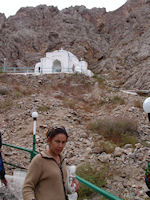

Figure 11: Paraw Bibi's shrine
Figure 12: Balancing stones
There are stories in many cultures that are similar to that of Ali and his horse. Stories and legends are often related to foot-prints and hand-prints left in stone, because of the vague appearance of the marks on the stone. Likewise there are stories of the disappearance of individuals through rock, conversion of individuals into rock, and the transformation of objects or animals into stone. People are said to pass into another realm by physical transfer through rock. Even the Christian bible carries echoes of some of these stories.
This is a local legend in Turkmenistan that illustrates many of the features related to stone. Paraw Bibi was a chaste and beautiful woman, who was envied by other women and desired by men. An ardent and unwanted suitor pursued her across the plains to the Kopet Dagh Mountains. She climbed high into the mountain and entered a small cave. She disappeared from there through the rock into another realm never to be seen again, leaving behind her hand- and foot-marks on the rock. The watermelon that she was eating remained behind; forever petrified.
This minute cave that only admits the passage of one body is now the second most important pilgrimage site in Turkmenistan. It is particularly special to women in their search for fertility and childbearing. This is strange, considering that Paraw Bibi was so concerned to preserve her chastity. It is also sought by sufferers of conditions related to the brain and mind. There is a shrine built over and protecting the access to the cave, and the walls are thickly covered with gifts that have been donated. The petitioners gather in the shrine to pray with an imam and to obtain a blessed piece of cloth, before then entering the confined space of the cave where they pray and look upon the vestiges of the foot- and hand-prints of Paraw Bibi. It is a significant climb up to the shrine, and down on the plain beneath is a well-used, but primitive, facility for picnics and overnight stops. Local people say that the Kopet Dagh Mountains are still growing and approximately every three months there are small tremors and grumbles from within, which helps to sustain the belief that there could be life within the rocks.
Outside the shrine the women indulge in another myth associated with Paraw Bibi. On a rock shelf there is a nondescript collection of stones, which they attempt to balance in a deliberate way on their fingertips. Successful balancing enables a wish to be made. Apparently, this is in some way related to the story of the petrified watermelon, although other records relate that successful balancing reflects absence from sin.
At Merv there is a shrine to the two companions of the prophet, and this is strongly associated with a fertility cult. Behind the encircling wall is a stone with a perforation through it that looks as though it was once a tethering stone for an animal. It is seen to have a distinctly greasy and shiny upper surface that looks like the marks of frequent manipulation. Its current use is quite different from that of the past. Young women who have failed to conceive are brought here, usually by their mother-in-law, and are required to masturbate on the stone in the hope of achieving a much-desired pregnancy. Outside the wall is the customary well-bedecked saxaul tree.
© Internet Archaeology/Author(s) URL: http://intarch.ac.uk/journal/issue26/24/4.html
Last updated: Wed Jul 29 2009